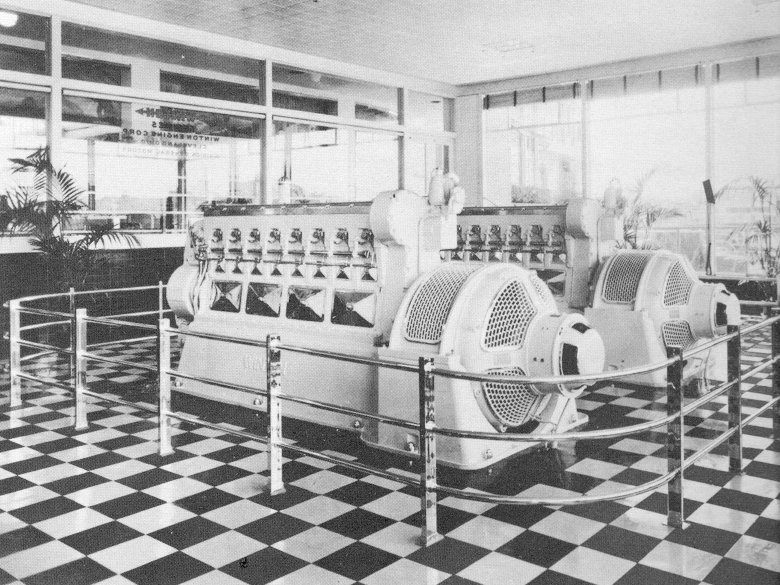Before the 8 cylinder had been run,
some
brave
soul decided it would be great to build two engines and have them
furnish
power for the General Motors Building at the 1933 Chicago Worlds Fair.
The U.S. Navy had been following this 2 cycle development work and had
given Winton a design contract for a "V" 12 cylinder engine which was
designed
concurrently with the 8 cylinder. These engines were known as the Model
201 and had a fabricated steel crankcase, one of the first in this
country.
A very unconventional cylinder head retainer design with a round head
similar
to the 567 was used. This was fastened in an 8 cylinder long aluminum
casting.
This casting carried the overhead camshaft, as well as the passages for
cooling water, fuel and lubricating oil. When the engine was first
started
these three liquids came out almost every place except where they
should.
After resorting to doping, peening, and everything in the book, the
first
engine was finally made to run. Immediately a new cylinder head
retainer
design in cast iron was started. After surprisingly few early troubles
the 8 cylinder engine was up to 600 HP and was doing it with a clean
exhaust
(well, almost clean) and with better fuel consumption than the 8
cylinder
8x10 4 cycle. In general the performance was very good. Not much
running
was done before this engine and its mate had to be sent to Chicago.
 From
here on the flow of rush parts from Cleveland and
Detroit to Chicago was fearful and wonderful. The boys worked all night
and hoped the engines would run all the next day. It was no fun but we
learned fast and a new design study was soon underway at Winton. To
mention the parts with which we had trouble in Chicago would take far
too much
time. Let it suffice to say that I do not remember any trouble with the
dip stick.
From
here on the flow of rush parts from Cleveland and
Detroit to Chicago was fearful and wonderful. The boys worked all night
and hoped the engines would run all the next day. It was no fun but we
learned fast and a new design study was soon underway at Winton. To
mention the parts with which we had trouble in Chicago would take far
too much
time. Let it suffice to say that I do not remember any trouble with the
dip stick.
E.W. Kettering, Chief Engineer, EMD
History and Development of the 567 Series General
Motors Locomotive Engine
Presented before the
American Society of Mechanical Engineers
November 29, 1951
RETURN
This page last updated 12-12-12
 From
here on the flow of rush parts from Cleveland and
Detroit to Chicago was fearful and wonderful. The boys worked all night
and hoped the engines would run all the next day. It was no fun but we
learned fast and a new design study was soon underway at Winton. To
mention the parts with which we had trouble in Chicago would take far
too much
time. Let it suffice to say that I do not remember any trouble with the
dip stick.
From
here on the flow of rush parts from Cleveland and
Detroit to Chicago was fearful and wonderful. The boys worked all night
and hoped the engines would run all the next day. It was no fun but we
learned fast and a new design study was soon underway at Winton. To
mention the parts with which we had trouble in Chicago would take far
too much
time. Let it suffice to say that I do not remember any trouble with the
dip stick.